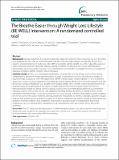| dc.identifier.citation | Ma, Jun, Peg Strub, Carlos A. Camargo, Lan Xiao, Estela Ayala, Christopher D. Gardner, A. Sonia Buist, William L. Haskell, Phillip W. Lavori, and Sandra R. Wilson. 2010. The Breathe Easier through Weight Loss Lifestyle (BE WELL) intervention: a randomized controlled trial. BMC Pulmonary Medicine 10: 16. | en_US |
| dc.description.abstract | Background: Obesity and asthma have reached epidemic proportions in the US. Their concurrent rise over the last 30 years suggests that they may be connected. Numerous observational studies support a temporally-correct, dose-response relationship between body mass index (BMI) and incident asthma. Weight loss, either induced by surgery or caloric restriction, has been reported to improve asthma symptoms and lung function. Due to methodological shortcomings of previous studies, however, well-controlled trials are needed to investigate the efficacy of weight loss strategies to improve asthma control in obese individuals. Methods/Design: BE WELL is a 2-arm parallel randomized clinical trial (RCT) of the efficacy of an evidence-based, comprehensive, behavioral weight loss intervention, focusing on diet, physical activity, and behavioral therapy, as adjunct therapy to usual care in the management of asthma in obese adults. Trial participants (n = 324) are patients aged 18 to 70 years who have suboptimally controlled, persistent asthma, BMI between 30.0 and 44.9 kg/m2, and who do not have serious comorbidities (e.g., diabetes, heart disease, stroke). The 12-month weight loss intervention to be studied is based on the principles of the highly successful Diabetes Prevention Program lifestyle intervention. Intervention participants will attend 13 weekly group sessions over a four-month period, followed by two monthly individual sessions, and will then receive individualized counseling primarily by phone, at least bi-monthly, for the remainder of the intervention. Follow-up assessment will occur at six and 12 months. The primary outcome variable is the overall score on the Juniper Asthma Control Questionnaire measured at 12 months. Secondary outcomes include lung function, asthma-specific and general quality of life, asthma medication use, asthma-related and total health care utilization. Potential mediators (e.g., weight loss and change in physical activity level and nutrient intake) and moderators (e.g., socio-demographic characteristics and comorbidities) of the intervention effects also will be examined. Discussion: This RCT holds considerable potential for illuminating the nature of the obesity-asthma relationship and advancing current guidelines for treating obese adults with asthma, which may lead to reduced morbidity and mortality related to the comorbidity of the two disorders. Trial registration NCT00901095 | en_US |


